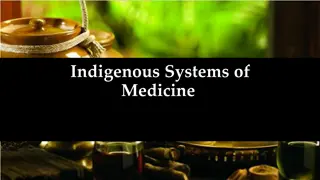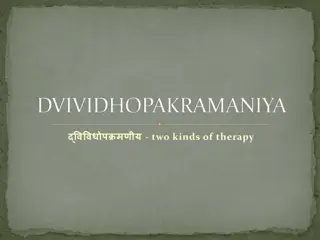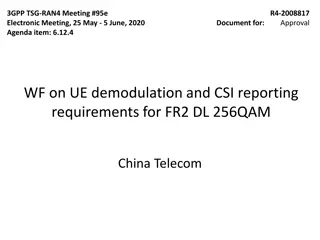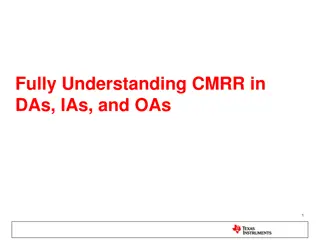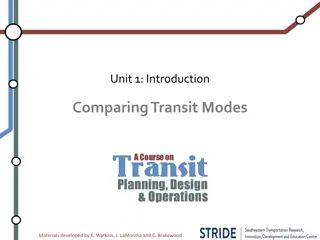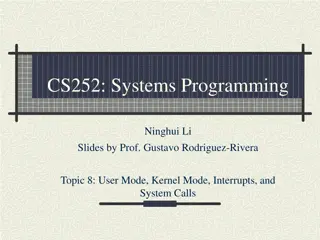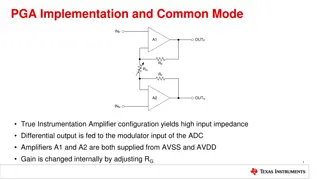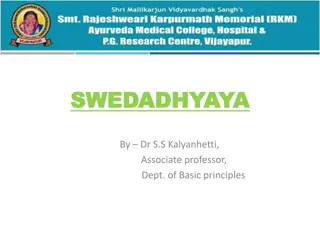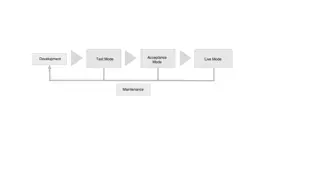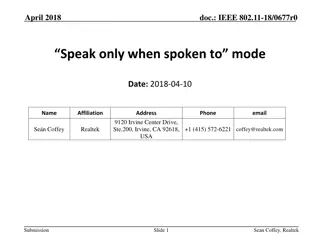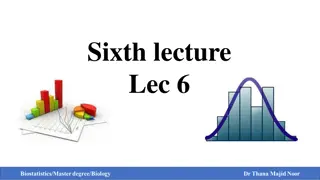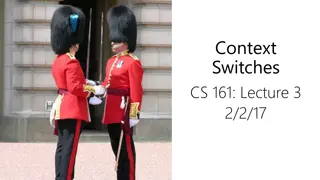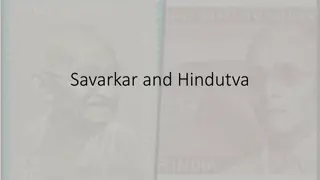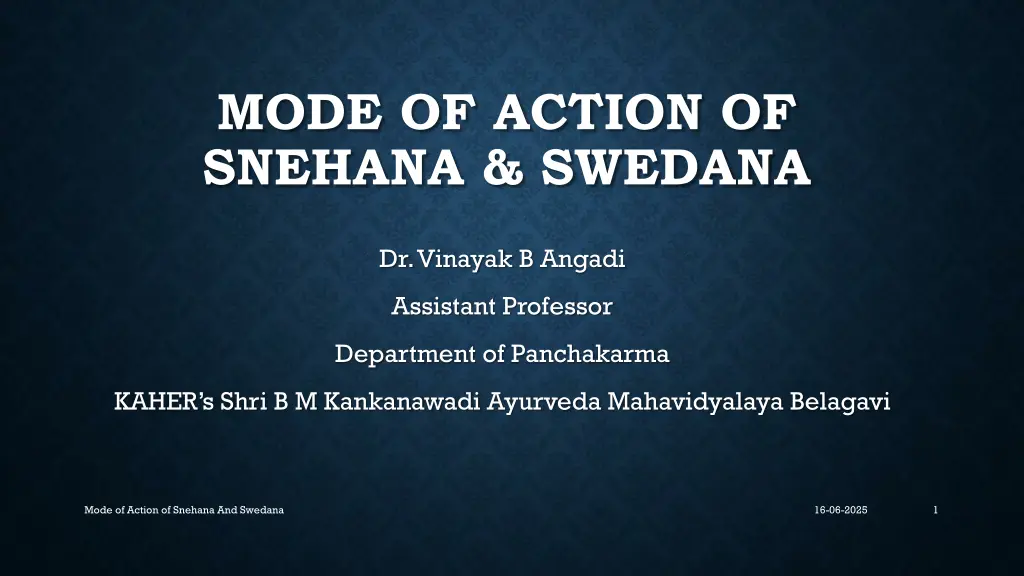
Understanding the Mechanism of Snehana and Swedana Therapies in Ayurveda
Explore the fascinating modes of action of Snehana and Swedana therapies in Ayurveda, as explained by Dr. Vinayak B. Angadi. Learn how these ancient practices impact the circulatory system and promote overall well-being through effective massage techniques.
Download Presentation

Please find below an Image/Link to download the presentation.
The content on the website is provided AS IS for your information and personal use only. It may not be sold, licensed, or shared on other websites without obtaining consent from the author. If you encounter any issues during the download, it is possible that the publisher has removed the file from their server.
You are allowed to download the files provided on this website for personal or commercial use, subject to the condition that they are used lawfully. All files are the property of their respective owners.
The content on the website is provided AS IS for your information and personal use only. It may not be sold, licensed, or shared on other websites without obtaining consent from the author.
E N D
Presentation Transcript
MODE OF ACTION OF SNEHANA & SWEDANA Dr. Vinayak B Angadi Assistant Professor Department of Panchakarma KAHER s Shri B M Kankanawadi Ayurveda Mahavidyalaya Belagavi Mode of Action of Snehana And Swedana 16-06-2025 1
MODE OF ACTION OF ABHYANGA
1. EFFECTS OF MASSAGE ON THE CIRCULATORY SYSTEM (a) On the Venous and the Lymphatic Flow Massage aids in the mechanical emptying of the veins and the lymphatic. It facilitates the forward movement of the venous blood and the lymph and thereby reduces the chance of stagnation of the blood and the lymph in the tissue space. The flow of the venous and the lymphatic channels from the extremities mainly depends on the activity of the smooth muscles, present in the walls of the vessels. The contraction of these small muscles in conjunction with the valves present in the vessels acts as a strong pumping mechanism, which keeps the tissue space clear from the free fluid.
CONTI. The contraction of the skeletal muscle compresses the blood vessels and exerts a pressure on the fluid present inside. This increase in intra vascular pressure stimulates the contraction of the smooth muscle present in the wall of the vessels. Contraction of smooth muscles further increases the pressure inside the vessels. When this pressure increases beyond the threshold, the valves open up and the fluid moves on to next segment. When the muscles relax, the segment is refilled by the fluid from the distal segments. This way the venous and the lymphatic fluids are allowed to move only in one direction.
CONTI The mechanical action of massage resembles with that of normal muscular contraction. The different techniques of massage alternately compress and release the soft tissue. This facilitates the venous and lymphatic flow. In case of fluid stagnation due to mechanical factors the flow of venous and lymphatic fluid is obstructed. Massage facilitates the drainage and reduces the stagnation of fluids and also speeds up the removal of waste products. According to Paikov7 the body contains 1200- 1500 ml of lymph moving at the speed of 4 mm/sec and massage increases the speed eight folds.
(B) ON BLOOD CELLS Few studies are available on the effect of massage on the blood cells.It state that RBC count increases after massage both in health and in anemia. Its also reported an increase in red blood cells and hemoglobin count following abdominal massage. This increase in RBC and hemoglobin count may increase the oxygen carrying capacity of blood. Increase in the platelets count after massage has been reported in an animal model. An increase in the neutrophil count following 30 minutes of massage performed 2 hours after intense exercise. Some studies did not observe any change in the neutrophil count following 20 minutes of massage. Though of late a number of studies have reported alteration in the leukocyte counts following massage in patients afflicted with AIDS and cancer. Increase in neutrophil count may have the potential to retard the inflammatory changes associated with strenuous exercises which may be of some use in the management of delayed onset muscle soreness.
2. EFFECT OF MASSAGE ON EXCHANGE OF METABOLITES Massage promotes rapid disposal of waste products and the replenishment of the nutritive elements. Massage also increases the movement of liquids and gases in the body. The increased arterial blood flow following massage brings more oxygen and nutritive elements and also causes more rapid oxygenation of the blood. Massage speeds up the lymphatic and venous flow, which promotes rapid disposal of the waste products of metabolism.
Mode of Action of Snehana And Swedana 16-06-2025 8
MODE OF ACTION OF SWEDANA Mode of Action of Snehana And Swedana 16-06-2025 9
SWEDANA DRAVYA AND ITS ACTIONS RESPONSIBLE FACTORS FOR STHAMBHANA : 1. Vyana vayu , shleshaka kapha , amarasa , mamsa , meda ,vasa 2. Vayu by ruksha guna absorbs snigdhata and also causes sthambha. 3. Swedana is snigdha and ushna so it relieves stambha. 4. Ushna guna of swedana does srotoshuddhi and amapachana and so it relieves stiffness. Mode of Action of Snehana And Swedana 16-06-2025 10
GAURAVAGHNA 1. Swedana relieves heaviness in the body. 2. It causes excreation of water content of the body through sweda. 3. Apya tatwa of kleda is guru. 4. Due to elimination of kleda , lightness is achieved. 5. Swedana stimulates muscles and nerves and so lightness is produced. Mode of Action of Snehana And Swedana 16-06-2025 11
SITAGHNA : Mainly due to ushna guna SWEDA KARAKA : 1. Swedana promotes sweating 2. Sweda is a type of mala , hence impurities of the , impurities of the body comes out with sweda. SROTAHA SU ABHIVILIYATE : 1. It helps to dissolve kapha which is in a dense stage ( grathita ) stuck to the channels firmly. 2. Further it liquifies kapha allowing it to move freely. Mode of Action of Snehana And Swedana 16-06-2025 12
KHANI MARDAVAM AYANTI : It makes the channels soften , by this vata flows in normal direction ( anuloma ) SLESHMA VISHYANDATE : It increases the secreations of vitiated kapha through the channels. Vishyandan = sravanam= to secrete Mode of Action of Snehana And Swedana 16-06-2025 13
Homones like epinephrine , cortisol , thyroid hormone are released Heating of tissues accelarates the chemical change Sympathetic activities increased Increased output of waste products including metabolites Increased demand for oxygen and food stuffs Increased metabolic rates Temperature control system employs two important mechanisms to reduce heat when body temperature is too hot during swedana karma vasodilatation Induction of sweating Mode of Action of Snehana And Swedana 16-06-2025 14
Higher temperatur e of blood stimulates thermoreceptors, send nerve impulses to the pre-optic area of the brain Stimulate the heat losing centre and inhibit heat promoting centre Nerve impulses from the heat losing center cause dilatation of blood vessels in the skin Excess heat is lost to the environment via radiation and conduction As a result of vasodilatation there is an increased blood flow through the area So that necessary oxygen and nutritive materials are supplied and waste products are removed Vaso dilataion ( sroto vispharana ) Leads to stimulation of sympathetic nervous system Increases circulation of rasa and rakta in the body Ushna guna Mode of Action of Snehana And Swedana 16-06-2025 15
CLINICAL RATIONALITY OF SWEDANA KARMA IN MSD Mode of Action of Snehana And Swedana 16-06-2025 16
REACTIVE ARTHRITIS As primarily Pitta dosha and Rakta dathu are associated with the Vata dosha the revelent swedana to be used are: Caused due to the inflammation in other parts of the body . {Cross-reactivity} Vata Conjunctivitis 1. Dashamoola Parisheka 2. Pinda taila Parisheka 3. Nirgundi Kashaya Parisheka 4. Yasti Ksheerapaka Parisheka 5. Salavana Upanaha 6. Brumhana Upanaha Pitta Arthritis Cervicitis Urethritis Rakta Mode of Action of Snehana And Swedana 16-06-2025 17
RHEUMATOID ARTHRITIS AMA VATA It is an autoimmune disorder characterized by the inflammatory arthritis of all major and minor joints associated with pain and stiffness. Pachana: 1. Valuka Sweda {Sankara Sweda} 2. Pinda sweda with Gophala, Yava. 3. Churna Pinda Sweda {Shatapushpa, Kola, Kullatha, Devadaru, Jatamamsi, Haridra, Rasna} 4. Jeeraka Pinda Sweda 5. Twak Nirgundi Parisheka 6. Dashamoola Prishaeka 7. Ushna Sadana, Guru pravarana 8. Upanaha and Atapa 9. Bhupaana (Ushna jala) Swedana for the purpose of Ama Swedana for the purpose of Shodhana: 1. Dashamoola Prisheka Ama Pachana 2. Dhanyamala Dhaara Vata Dosha 3. Kupilu Kshreepaka Dhaara Note: These not only help for the purpose as purva karma for shodhana but also helps to subside Pain and stiffness. Kapha Dosha Shodhana Ama in the Kapha Sthana Rasayana Mode of Action of Snehana And Swedana 16-06-2025 18
SCIATICA - GRIDRASI Swedana which can be indicated in Sciatica: Sciatica is a neurological pain caused due to the injury / compression of the sciatic nerve roots its is characterized by the pain in low back region radiating to lower limbs. 1. Patra pinda Sweda 2. Jambira pinda sweda 3. Naadi Sweda 4. Taila Prisheka 5. Kashaya Prisheka Vata Dosha Note: One should select such a sweda which does swedana without doing the vata prakopa. Shoshana of Kapha Sakti Utskepa Nigraha Mode of Action of Snehana And Swedana 16-06-2025 19 Rationality Of Different Swedana Karma In Musculoskeletal Disorders 16-06-2025
FACIAL PALSY - ARDITA Swedana which can be indicated in Ardita: Bell s palsy is a condition that causes temporary weakness or paralysis of the muscles in the face. The condition causes one side of face droop or become stiff leading to difficulty in smiling, closing of eye on the affected side. 2. Ksheera dhooma 3. Dashamoola Ksheera dhooma 4. Bala Ksheerapaka dhooma 5. Varunadi Ksheera dhooma 6. Masha bala Ksheera dhooma 7. Vyayama ??? 1. Panasa patra sweda Kapha Vata Note: One should select such a sweda which are snigdha in nature. Snayu Sankochana Mode of Action of Snehana And Swedana 16-06-2025 20
FROZEN SHOULDER - AVABAHUKA Adhesive capsulitis, also known as a frozen shoulder, is a painful and disabling disorder of unclear cause in which the shoulder capsule, the connective tissue surrounding the glenohumeral joint of the shoulder, becomes inflamed and stiff, greatly restricting motion and causing pain. 2. Patrapinda Sweda 3. Valuka Sweda 4. Dashamoola Parisheka 5. Naadi Sweda Swedana which can be indicated in Avabahuka: 1. No need of Sneha Kapha Vata Note: One should select such a sweda which are ruksha initially later snigdha in nature. Pitta Avabahuka Mode of Action of Snehana And Swedana 16-06-2025 21
OSTEOARTHRITIS SANDHIGATA VATA Swedana which can be indicated in Sandhigata Vata: Osteoarthritis is a form of arthritis that features the breakdown and eventual loss of the cartilage of one or more joints. 1. Amaja Upanaha 2. Niramaja Upanaha 3. Dashanga Lepa 4. Janu Basti 5. Patra pinda Sweda 6. Shastika Shaali Pinda Sweda 7. Eranda + Nirgundi Parisheka 8. Dashamoola Prisheka Vata Dosha Kapha Sthana Sandhigata Vata Note: One should select such a sweda which are snigdha and brumhana in nature. Mode of Action of Snehana And Swedana 16-06-2025 22
THANK YOU Mode of Action of Snehana And Swedana 16-06-2025 23


